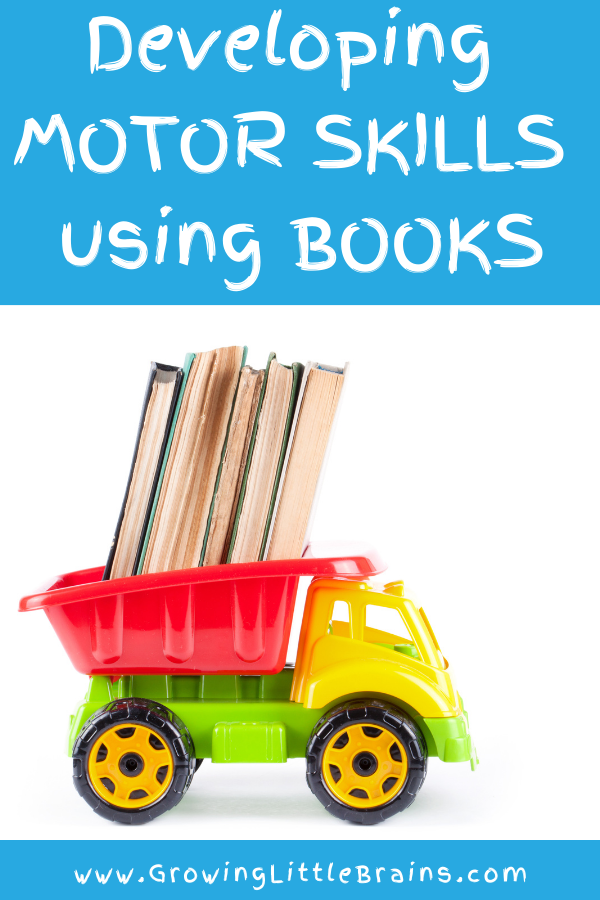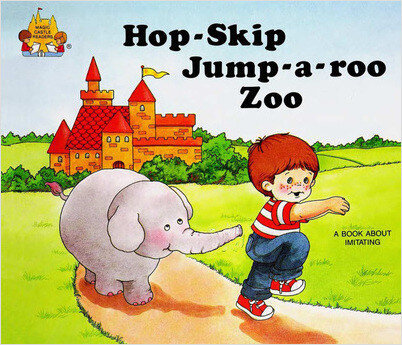Developing Sensory Motor Skills with Books!
Books are not just for reading! They can develop many other developmental skills that children need for learning. Read this post to find ways to promote sensory motor, gross motor and fine motor skills with young children through books. Don’t miss the additional resources that are shared to help therapists, teachers and parents use books to develop children’s motor skills.
Do you have a favorite children’s book?
What is your child’s favorite book?
Books are so versatile and one of my favorite activities to use during Occupational Therapy sessions with young children.
I know what you might be thinking? Books are for reading….how can they work on motor skills?
In my earlier years of practice, I thought books were tools used mainly by teachers and speech therapists to facilitate early language, communication and reading skills.
I didn’t realize there were so many other skills that books could promote until I had my own children and spent more time reading to them and following their lead.
I love picking a few books each month based on a theme and using them during my OT sessions to focus on whole child development.
Other skills that books can promote
Visual scanning (to find a certain picture, color, object, letter)
Fine motor (turning the pages, pointing)
Gross motor (imitating body postures in the book)
Self-regulation (sitting still and paying attention)
Social-emotional (so many great books that teach lessons about feelings and what to do with them)
Cognitive (by asking questions about the book at the end we work on memory, attention, problem solving and critical thinking just to name a few!)
Self-care (books on dressing, brushing teeth, potty)
So basically, there are books to focus on every area of development needed for children to learn and grow!
The best part about learning through books is that it’s fun and you’ll never need worksheets again!
How to choose the right books
For babies, black and white books are great for developing their visual skills.
For older babies, touch and feel board books are great for developing their sensory systems.
For toddlers, board books with colorful pictures and lift and flap books are great for keeping their attention.
For preschool age children, short books that rhyme are great as well as books that tap into their interests.
For older children, follow their interests and reading level. A good way to find the “just right” challenge is by following the five finger rule.
Books that promote sensory motor skills
Young children learn best through sensory-motor experiences. Simply stated-they learn best when they can touch, feel, move, hear, see, and do!
Young children are not built to sit still for long. Their brains crave movement when they are young because movement is how they learn about the world!
If you have a young child that has a hard time sitting still for storytime, this is totally normal!
Instead, try to use books that encourage movement so you can start building their attention and interest in books.
Look for books that encourage your child to do new motions with their body, fingers, follow directions, and explore their environment.
Some of my favorite books to encourage sensory-motor development include:
Head to Toe by Eric Carle
Brown Bear, Brown Bear by Eric Carle
We’re going on a Bear Hunt by Michael Rosen and Helen Oxenbury
The Very Hungry Caterpillar by Eric Carle
Pete the Cat books by James Dean
Jump, Frog, Jump! by Robert Kalan
Barnyard Dance by Sandra Boynton
Move! by Steve Jenkins and Robin Page
You are a Lion by Taeeun Yoo
Hop-Skip-Jump-A-Roo Zoo by Jane Belk Moncure
ABC Yoga By Christiane Engel
Jonathan and his Mommy by Irene Smalls
Ways to use books via teletherapy
My first choice is to check with the family to see if they have a hardcopy of the book. If I’ve planned enough in advance, I will let my families know the books we are targeting for the month and have them check them out at the library if possible.
If the family does not have the hardcopy of the book, I will find a recorded version on YouTube to share on my screen during teletherapy sessions. I look for versions of the story that clearly show the pages of the book. After locating the video I like, I will convert it to a SafeYouTube link for sharing during teletherapy sessions. Often, I will mute the recording and I will read the story or have the parent read the story. By doing this, we can slow the pace down and focus on adding some movements or following directions.
Vooks are read-along animated storybooks. My kids love these! You can receive a free trial for 30 days by using this link! They have lots of free books and resources too! Be sure to check out their resources where they have activity ideas and reading comprehension questions to coordinate with the stories.
This website streams videos featuring celebrated actors reading children’s books alongside creatively produced illustrations. A great way to see how to use the power of voice to bring different characters to light!
Need more help in selecting motor activities for your child?
While working in preschool and Early Intervention for many years, I have collected many fine motor, gross motor and sensory motor activity ideas with popular children’s books.
Building on a child’s love of certain books is a very motivating and a fun way to learn new skills.
Even though children love repetition, I know that reading Goodnight Moon for the 1,000th time can make a parent crazy!
This is exactly how some of these activities evolved for me…my children were stuck on reading the same book, but I needed to move on to trying some new things for my sanity.
If you are interested in purchasing this resource you can find it in the Growing Little Brains shop.
The Book activity bundle includes:
Several books based on a theme. These books and activities are geared towards ages 2-6.
Coordinating one page handout for each book with a fine motor, sensory motor and gross motor activity to pair with that book. It’s a printable pdf version perfect for sharing with families or posting on your fridge as a reminder to try new things!
The YouTube (Safe YouTube) link for the book for easy access to use during teletherapy sessions via screen share or to use at home with your children if you don’t have a hardcopy of the book.
Activities that require no or limited materials and most additional items needed are commonly found household items.
A parent handout for other activity ideas and tips for reading books with young children.
Grab your copy of the book activities here!
Continue to explore books with your children and find their favorites. If you’re in need of some new recommendations or activities reach out and let me know!
If you liked this post, check out these other posts too!
7 things to do instead of academic worksheets
20 Awesome movement songs for kids
73 Backyard activities to keep kids busy all summer
Surviving Coronavirus social distancing with a toddler






